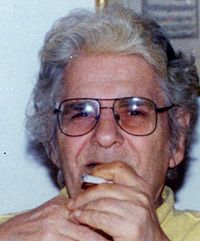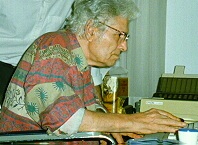Ahmad Shamlou facts for kids
Quick facts for kids
Ahmad Shamlou
|
|
|---|---|
 |
|
| Born | December 12, 1925 Tehran, Iran |
| Died | July 23, 2000 (aged 74) Karaj, Iran |
| Occupation | Poet, Encyclopedia and Journalism |
| Nationality | Iranian |
| Period | 1947–2000 |
| Literary movement | Modern literature |
| Notable works | In This Blind Alley The Book of Alley |
| Notable awards |
|
| Signature | |
 |
|
Ahmad Shamlou (Persian: احمد شاملو, Ahmad Šāmlū Persian pronunciation: [æhˈmæd(-e) ʃɒːmˈluː]), also known as A. Bamdad (Persian: ا. بامداد), was a famous Iranian poet, writer, and journalist. He lived from December 12, 1925, to July 23, 2000. Many people believe he was the most important poet in modern Iran.
Shamlou's early poems were inspired by Nima Yooshij, another important Iranian poet. Critics say Shamlou had a huge impact on poets of his time, second only to Nima. His poems can be complex, but their strong images are easy to understand. He used traditional Iranian images, like those found in the works of famous poets Hafez and Omar Khayyám. He also added everyday images and unique combinations of ideas that were new to Persian poetry.
Besides writing his own poems, Shamlou translated many books from French into Persian. His own works have also been translated into many languages. He wrote plays, edited works by classical Persian poets like Hafez, and even wrote for children. His thirteen-volume book, Ketab-e Koucheh (The Book of Alley), is a very important collection that helps us understand Iranian folklore and language. He also wrote fiction and movie scripts, and worked as a journalist.
Contents
Biography
Early Life and Education
Ahmad Shamlou was born on December 12, 1925, in Rasht, Iran. His father was in the army, so Ahmad and his five siblings moved around a lot. He went to school in different cities like Khash, Zahedan, Mashhad, and Rasht. Moving so often made it hard for him to finish his education.
In 1941, he moved to Tehran, hoping to attend a technical school and learn German, but he had to repeat two years of school. His family moved again in 1942 to Gorgan. He tried one last time to finish high school in Urumieh in 1945 but didn't succeed. When he was 29, Shamlou was arrested and spent over a year in prison because of his political beliefs.
Early Work and Challenges
Shamlou's first book of poems, Forgotten Songs, came out in 1947. In 1948, he started writing for a literary magazine. Two years later, his first short story was published. His second poetry collection, Manifesto, came out in 1951. He was interested in socialist ideas and even worked as a cultural advisor at the Hungarian embassy.
However, his third poetry book, Metals and Sense (1952), was banned and destroyed by the police. Many of his translations and notes for The Book Of Alley were also taken and destroyed. In 1954, he was jailed for 14 months. After his release, he continued translating novels. In 1956, he became the editor of a literary magazine called Bamshad.
Rising to Fame
Shamlou became very famous after his poetry book Fresh Air (Persian: هوای تازه) was published in 1957. A poet and philosopher named Zia Movahed said that the language and style in Fresh Air were completely new and different. He called it "the greatest event in our poetry" after the classical poet Hafiz.
In 1958, his translation of the novel Barefoot showed how skilled he was as a translator. By 1959, he started writing short stories for children and also began directing documentary films.
Busy Years of Writing and Editing
In 1960, Shamlou released another collection of poems called The Garden of Mirrors. The next year, he became the editor-in-chief of Ketab-e-Hafte, a magazine that changed how literary journalism was done in Iran. He continued to publish translations and new poetry collections like Ayda in Mirror and Moment and Eternity in 1964.
In 1965, he released Ayda, Trees, Memories and the Dagger and started his third attempt to put together The Book of Alley. In 1966, his book Phoenix in the Rain was published, but his literary magazine was closed down by the government.
Shamlou became editor of Khusheh in 1967. He also helped create the Union of Iranian Writers and gave poetry readings at universities. In 1968, he began studying the works of Hafez, a famous classical Persian poet. He translated poems by Federico García Lorca and parts of Song of Solomon from the Old Testament. He also organized a successful week of poetry readings for both new and established Iranian poets. In 1969, his weekly magazine was again closed by the police. He published a selection of older poems and a new collection called Odes for the Earth.
Later Works and International Recognition
In 1970, Blossoming in the Mist was published. He also directed documentary films for TV and wrote children's stories. In 1972, he taught Persian literature at Tehran University and became a member of the Iranian Academy of Language. He released audio recordings of himself reading poems and wrote movie scripts. He also traveled to Paris for medical treatment.
In 1973, two new poetry collections, Abraham in Fire and Doors and the Great China Wall, were released. "The Song of Abraham in Fire" is one of his most famous poems. It tells the story of a hero who sacrifices himself for his land and love, but is misunderstood by others. In 1975, he published his study of Hafez. In 1976, he visited the United States, giving poetry readings and attending the San Francisco Poetry Festival.
In 1977, his new poem, Dagger on the Plate, was published. He left Iran to protest against the Shah's government and stayed in the United States for a year, giving lectures at universities. In 1978, he moved to Britain to edit a new publication, but he resigned and returned to Iran after the revolution. He rejoined the Union of Iranian Writers and started a successful new magazine called Ketab-e Jom'e. He was very active in 1978 and 1979, publishing many poems and translations, giving lectures, and being elected to the Writer's Union leadership. The first two volumes of The Book of Alley were also printed.
Final Years
From 1980 onwards, because of the difficult political situation in Iran, Shamlou lived a more private life for eight years. He worked with his wife, Ayda, on The Book Of Alley and other literary projects, including a translation of And Quiet Flows The Don. In 1984, he was nominated for the Nobel Prize in Literature.
In 1988, he was invited to the World Literary Congress and toured Europe, giving many lectures and readings. His complete collection of poems was printed in Germany. In 1990, he toured the United States and received an award from Human Rights and The Fund For Freedom of Expression. Many books were published about his poetry and his contributions to literature.
In 1991, he toured Europe again before returning to Iran for four more years of intense work. That same year, he won the Freedom of Expression Award from Human Rights Watch. In 1992, his work Sacred Words was published in Armenian and English. In 1994, he toured Sweden, giving lectures and readings.
In 1995, he finished translating And Quiet Flows The Don. Iranian writers and critics gathered in Toronto to discuss his impact on Persian poetry. His book Aurora! was also published in Spanish. In 1999, he received the Stig Dagerman Prize from a Swedish foundation.
Personal Life
Ahmad Shamlou was married three times. His first marriage was to Ashraf Isslamiya in 1947, and they had three sons and a daughter. They divorced in 1957. His second marriage was to Tusi Hayeri Mazandarani, which ended in 1963.
In 1962, he met Aida Sarkisian, and they married in 1964. Aida came from an Armenian-Iranian family. Her family initially didn't approve because Shamlou was older and had been divorced twice. However, Aida became a very important person in Shamlou's life. They stayed together until he passed away in 2000, and her name appears in many of his later poems.
Death
Shamlou's health got worse in 1996 due to several illnesses. He had many operations, and in 1997, his right foot had to be removed because of severe diabetes problems. He passed away on July 23, 2000, at his home in Karaj, due to complications from diabetes. Thousands of people attended his funeral on July 27, and he was buried in Emamzadeh Taher, Karaj.
Works and Style
Ahmad Shamlou wrote over seventy books. These include 16 volumes of poetry, 5 poetry collections, 5 books with novels for kids, short stories, and screenplays. He also wrote 9 children's books, translated 9 poetry books and 21 novels into Persian, and published 5 collections of essays, lectures, and interviews. His most extensive work is The Book Of Alley, which has 10 volumes so far.
Shamlou's poetry combines ideas from Western Modernist art with modern changes to classical Persian poetry. Poets like Federico García Lorca and Langston Hughes, and writers like Louis Aragon and Nima Yooshij, influenced him. Shamlou was a follower of Nima Yooshij and always looked for new ways to write poems. He quickly became a leader for young Iranian poets and writers, including Forough Farrokhzad and Sohrab Sepehri.
Shamlou is known for using everyday language in his poems. He created a simple, free poetic style called Sepid Persian Poetry (meaning 'white poetry'). This style is a type of free verse that doesn't follow the strict rhythms and rhymes of older Persian poetry. His poems often talk about political issues, especially freedom, and the human experience.
His poems are full of mythological ideas and symbols. He often praised ordinary people who were punished for their revolutionary beliefs, showing their deep love for their country. While focusing on the goodness of these individuals, many of whom were his friends, Shamlou also bravely criticized the unfairness and cruelty he saw in society.
Political Views
Shamlou was a Marxist and an intellectual who cared deeply about society. He combined personal feelings of love with his social views in his writing. He was a major voice against the former Shah of Iran before the 1979 revolution.
Throughout his life, Shamlou was politically active and was imprisoned twice: once after World War II and again after the 1953 coup. Even after the Iranian Revolution, he continued to write poems that criticized society and politics. In 1976, he left Iran to protest against censorship and the lack of freedom. In 1977, he signed a letter supporting the rights of writers. The new Islamic government did not like him, seeing him as someone against Islam and too Western. However, because he was so popular, they couldn't arrest him, but they didn't allow his works to be published for many years. Since the early 1990s, his poems have started appearing in many literary magazines again.
Awards
- Forough Farrokhzad Prize, 1973
- Freedom of Expression Award given by Human Rights Watch, 1990
- Stig Dagerman Prize, 1999
- Free Word Award given by Poets of All Nations in Netherlands, 2000
Books
- The Forgotten Songs (1947)
- The Verdict (1951)
- Poems of Iron and Feelings (1953)
- Fresh Air (1957)
- The Mirror Orchard (1960)
- Ayda in the Mirror (1964)
- Moments and Forever (1964)
- Ayda: Tree, Dagger, Remembrance (1965)
- Phoenix in the Rain (1966)
- Blossoming in the Mist (1970)
- Abraham in the Fire (1973)
- The Doors and the Great Wall of China (1973)
- Of Airs and Mirrors (1974)
- Poniard on the Plate (1977)
- Little Rhapsodizes of Exile (1979–1980)
- Unrewarded Eulogies (1992)
- The Cul-de-Sac and the Tigers in Love (1998)
- The Tale of Mahan's Restlessness (2000)
- The Book of Alley (1978–present)
Books in Translation
In English Translation
- Talebi, Niloufar (2019). Self-Portrait in Bloom. ISBN 978-91-7637-565-5. OCLC 1088892324., includes translations of 30 works.
- Shāmlū, Aḥmad (2015). Born upon the dark spear : selected poems of Ahmad Shamlu. New York. ISBN 1-940625-16-5. OCLC 944092723.
- Shāmlū, Aḥmad; Papan-Matin, Firoozeh; Lane, Arthur (2005). The love poems of Ahmad Shamlu. Bethesda, Md.: IBEX Publishers. ISBN 1-58814-037-7. OCLC 56329283.
In French Translation
- Châmlou, Ahmad. Choix de poèmes, tr. Ahmad Kamyabi Mask. Paris: A. Kamyabi Mask, 2000. ISBN: 9782910337070
- S̆āmlū, Aḥmad. Hymnes d'amour et d'espoir. tr. Parviz Khazrai. Orphée, La Différence, 1994.
- Shamlou, Ahmad. "Hurle-moi", tr. Sylvie Mochiri Miller. L'Harmattan, collection Iran en Transition, 2021 ISBN: 9782343221908
- Shamlou, Ahmad. La Passion de la Recréation. Poésies. Tr. Media Kashigar et Jalal Alavinia, Ed. Lettres Persanes, 2022. 368 pages. 125 poèmes. Biographie complète. ISBN: 9782916012230
Work Inspired by Poetry of Ahmad Shamlou
The Fairies Opera
In 1989, the Persian-Canadian composer Sheida Gharachedaghi created an opera based on Shamlou's poem The Fairies. This opera was performed live in Toronto in 1989. A CD of this performance was released in July 2020 to mark 20 years since Shamlou's death. The composer tried to release the CD in Iran, but it was not allowed because of rules against solo female singing. A British magazine noted that the opera's lyrics, which talk about singing, dancing, and overcoming darkness, likely caused the ban.
Abraham in Flames Opera
Abraham in Flames (ابراهیم در آتش) is an opera created by Niloufar Talebi with composer Aleksandra Vrebalov. It premiered in May 2019 in San Francisco. This opera was inspired by the images and ideas in Shamlou's life and poetry, especially the idea of facing challenges like fire to find truth. The opera was praised as a great achievement and was chosen as a "Best in New Music and Classical Performance" by the San Francisco Chronicle in 2019.
See Also
 In Spanish: Ahmad Shamlú para niños
In Spanish: Ahmad Shamlú para niños
- Intellectual movements in Iran


